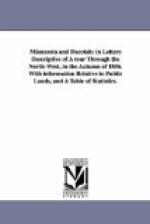I allude to these traits because I think it will be agreed, that whatever race possesses those elements of character which lead them to pursue with zeal and courage things they have been taught to regard most creditable, is capable of being civilized. We now pay the Indian for his lands in agricultural tools, in muskets and powder, in blankets and cheap calico— and in education; but the smallest item is education. If half the money which the government is liable to pay for Indian troubles during the last year, could be appropriated to a proper system of education, we should hear of no more serious Indian wars. But I have not time to pursue the subject. I will say, however, that the present commissioner of Indian affairs, Mr. Manypenny, is doing a very good work in advancing their condition. The press ought to bestow some attention on the subject. There are nearly 400,000 Indians within the United States and territories. If the philanthropy of the age could spare the blacks for a little while, and help civilize the Indians, it would be better for all parties. Here is an enterprise for genuine humanity.
LETTER VIII.
Lumbering interests.
Lumber as an element of wealth— Quality of Minnesota lumber— Locality of its growth— The great pineries— Trespasses on government land— How the lumbermen elude the government— Value of lumber— Character of the practical Lumberman— Transportation of lumber on rafts.
Crow Wing, October 1856.
It seems to have been more difficult for countries which abound in precious metals to attain to great prosperity than for a rich man to secure eternal felicity. Witness, for instance, the sluggish growth and degenerate civilization of the South American states. But timber is a fundamental element of colonial growth. The mines of Potosi cannot compare with it in value. An abundance of timber and a superabundance of it are two very different things. Some of the Middle, and what were once Western States, were originally covered with forests. So of the greater part of New England. In Ohio and in Michigan timber has been an encumbrance; for there was great labor to be performed by the settler in clearing the land and preparing it for the plough; and at this day we see in travelling through each of those states, as well as in Kentucky, Tennessee, and Missouri, fields planted amidst heavy timber trees which have been belted that they may wither and die. By an abundance of timber I mean an ample supply not only for domestic but foreign market; and with this understanding of the word I will repeat what has often been said, and what I suppose is well known, that Minnesota has an abundance of excellent timber. Unlike the gorgeous forests in New Hampshire, which behind high cliffs and mountain fastnesses defy the woodman, the timber of Minnesota grows in the valleys of her great rivers and upon the banks of their numerous tributaries. It is thus easily shipped to a distant market; while the great body of the land, not encumbered with it, but naked, is ready for the plough and for the seed. Most of the timber which grows in the region below this point is hard wood, such as elm, maple, oak, and ash.




